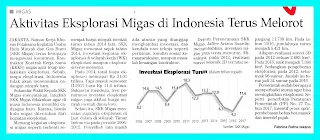PT Saka Energi Indonesia took the auction document of oil and gas block offered by the government. There are two blocks of interest to the subsidiary of PT Perusahaan Gas Negara Tbk (PGN), from 15 oil and gas blocks auctioned by the government since last May.
Both blocks are Pekawai Block and West Yamdena-Papua Block. Both have indeed conducted a joint study between Saka Energy and the government. That way, Saka Energy has a great chance of winning in an oil and gas block auction by 2017.
Nevertheless, Saka Energi has not made a bid for the Bloc of the Pekawan and the West Yamdena Block. President Director Saka Tumbur Parlindungan, jokingly said, it was just about to bid ahead of the government's proposed deadline.
"Not yet, when the auction is closed," he said on Friday; (29/9). What is certain according to Tumbur, it is indeed interested in both oil and gas blocks.
In addition to targeting new oil and gas blocks in this year's auction of working areas, Tumbur also revealed that Saka Energy hopes to join the termination blocks. One of them participated in the termination block that was handed over by the government to Pertamina.
"If Pertamina does not want 100%, given to us alone," he said.
One of Saka Energi's block of terminations is the Sanga-Sanga Block. Currently Saka has about 37% participating interest (PI) in the Sanga-Sanga block. Saka is also a joint operator with ENI Indonesia which also has a 37% participating interest (Pl).
"The government has given Pertamina for the next management," he said.
But decisions regarding these termination blocks will still be left to the government. Until now, Saka Energi has not yet held talks with Pertamina related to the Sanga-Sanga Block. The SOE has not yet signed the block contract.
While hoping to get an assignment from the government, Saka continues to develop the blocks he operates, one of which is Ujung Pangkah Block, East Java. Recently Saka has proposed a plan of development (POD) Ujung Pangkah Block to the Special Unit for Upstream Oil and Gas Business (SKK Migas).
"Drilling last year," said Tumbur, Production of 10,000 barrels per day.
IN INDONESIA
Saka Energi Ikut Lelang Dua Blok Migas
PT Saka Energi Indonesia ikut mengambil dokumen lelang blok minyak dan gas yang ditawarkan oleh pemerintah. Ada dua blok yang menarik hati anak usaha PT Perusahaan Gas Negara Tbk (PGN) itu, dari 15 blok migas yang dilelang pemerintah sejak bulan Mei lalu.
Kedua blok tersebut adalah Blok Pekawai dan Blok West Yamdena-Papua. Keduanya memang telah dilakukan studi bersama antara Saka Energi dan pemerintah. Dengan begitu, Saka Energi memiliki peluang besar menang dalam lelang blok migas tahun 2017.
Biarpun begitu, Saka Energi ternyata belum mengajukan penawaran untuk Blok Pekawan dan Blok West Yamdena. Direktur Utama Saka Tumbur Parlindungan, sambil bercanda mengatakan, pihaknya baru saja akan mengajukan penawaran menjelang batas akhir pengajuan penawaran yang ditetapkan pemerintah.
"Belum, nanti saja kalau lelang sudah ditutup," katanya, pada Jumat; (29/9). Yang pasti menurut Tumbur, pihaknya memang berminat pada kedua blok migas tersebut.
Selain mengincar blok-blok migas baru dalam lelang wilayah kerja tahun ini, Tumbur juga mengungkapkan, Saka Energi berharap bisa ikut masuk ke blok-blok terminasi. Salah satunya ikut dalam blok terminasi yang diserahkan pemerintah ke Pertamina.
"Kalau Pertamina tidak mau 100%, diberikan kepada kami saja," ujarnya.
Salah satu blok terminasi yang diincar Saka Energi adalah Blok Sanga-Sanga. Saat ini Saka memiliki sekitar 37% participating interest (PI) di blok Sanga-Sanga. Saka juga menjadi operator bersama dengan ENI Indonesia yang juga memiliki hak partisipasi (Pl) sekitar 37%.
"Pemerintah memberi Pertamina untuk pengelolaan selanjutnya. Katanya mau mencari mitra, kami mau. Saka sudah ada disitu," katanya.
Namun keputusan terkait blok-blok terminasi ini akan tetap diserahkan kepada pemerintah. Hingga saat ini Saka Energi belum melakukan pembicaraan dengan Pertamina terkait Blok Sanga-Sanga. BUMN itu belum menandatangani kontrak blok tersebut.
Sembari berharap mendapat penugasan dari pemerintah, Saka terus mengembangkan blok-blok yang ia operasikan, salah satunya Blok Ujung Pangkah, Jawa Timur. Baru-baru ini Saka telah mengajukan plan of development (POD) Blok Ujung Pangkah ke Satuan Kerja Khusus Pelaksana Kegiatan Usaha Hulu Minyak dan Gas Bumi (SKK Migas).
"Pengeboran tahun lalu," kata Tumbur, Produksinya 10.000 barel per hari.
Kontan, Page-14, Monday, October 2, 2017















